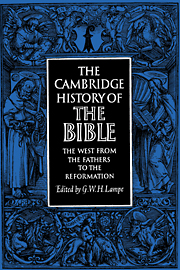Book contents
- Frontmatter
- I The Old Testament: Manuscripts, Text and Versions
- II The History of the Text and Canon of the New Testament to Jerome
- III Early Christian Book-Production: Papyri and Manuscripts
- IV Jerome
- V The Medieval History of the Latin Vulgate
- VI The Exposition and Exegesis of Scripture
- VII The ‘People's Bible’: Artists and Commentators
- VIII Bible Illustration in Medieval Manuscripts
- IX The Vernacular Scriptures
- X Erasmus in Relation to the Medieval Biblical Tradition
- Bibliography
- Notes on the Plates
- Index
- References
VII - The ‘People's Bible’: Artists and Commentators
Published online by Cambridge University Press: 28 March 2008
- Frontmatter
- I The Old Testament: Manuscripts, Text and Versions
- II The History of the Text and Canon of the New Testament to Jerome
- III Early Christian Book-Production: Papyri and Manuscripts
- IV Jerome
- V The Medieval History of the Latin Vulgate
- VI The Exposition and Exegesis of Scripture
- VII The ‘People's Bible’: Artists and Commentators
- VIII Bible Illustration in Medieval Manuscripts
- IX The Vernacular Scriptures
- X Erasmus in Relation to the Medieval Biblical Tradition
- Bibliography
- Notes on the Plates
- Index
- References
Summary
In the eyes of the biblical writers, the course of history seemed to be not only the training-ground of the human spirit but also a sphere in which were displayed the workings of the power of God. History might thus provide abundant examples of the faithfulness, or the perversity, with which mankind responds to the unshakeable ‘commandments and statutes and judgements of the Lord’, yet it is more than the ‘storehouse containing all the countless lessons of the past’, which Cicero held it to be, since it bears the majestic impress of the divine. The richly significant run of events is therefore to be valued, both for its own sake, as a story with a moral, and as offering intimations and symbols of a deeper truth: in the language of Sir Thomas Browne, ‘unspeakable mysteries are delivered in a vulgar and illustrative way’ because ‘while we are veiled in with mortality, truth must veil itself too, that it may the more fully converse with us’. The historical writings of the Old and New Testament serve to teach men the lessons which make them wise unto salvation, and also by their hints of ‘something far more deeply interfused’ propose limitless subjects for contemplation and reverence. Christian history teaches and suggests, and what applies to Christian history applies to Christian art as well.
The early painters and sculptors record biblical scenes in faithful and naïvely literal fashion; yet symbolism keeps breaking in, since the events acquire fuller dignity and importance as offering glimpses of supernatural truth. In other words, the picture is used to express something beyond that which is, or was at the time, immediately apparent, and to arouse in the spectator feelings and thoughts derived from the event which is actually portrayed. The earliest Christian art, that of the Roman catacombs, is symbolic through and through.
- Type
- Chapter
- Information
- The Cambridge History of the Bible , pp. 280 - 308Publisher: Cambridge University PressPrint publication year: 1969
References
- 1
- Cited by

